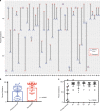Forty-five patient-derived xenografts capture the clinical and biological heterogeneity of Wilms tumor
- PMID: 31862972
- PMCID: PMC6925259
- DOI: 10.1038/s41467-019-13646-9
Forty-five patient-derived xenografts capture the clinical and biological heterogeneity of Wilms tumor
Abstract
The lack of model systems has limited the preclinical discovery and testing of therapies for Wilms tumor (WT) patients who have poor outcomes. Herein, we establish 45 heterotopic WT patient-derived xenografts (WTPDX) in CB17 scid-/- mice that capture the biological heterogeneity of Wilms tumor (WT). Among these 45 total WTPDX, 6 from patients with diffuse anaplastic tumors, 9 from patients who experienced disease relapse, and 13 from patients with bilateral disease are included. Early passage WTPDX show evidence of clonal selection, clonal evolution and enrichment of blastemal gene expression. Favorable histology WTPDX are sensitive, whereas unfavorable histology WTPDX are resistant to conventional chemotherapy with vincristine, actinomycin-D, and doxorubicin given singly or in combination. This WTPDX library is a unique scientific resource that retains the spectrum of biological heterogeneity present in WT and provides an essential tool to test targeted therapies for WT patient groups with poor outcomes.
Conflict of interest statement
The authors declare no competing interests.
Figures







Similar articles
-
Characterizing Sensitivity to Vincristine, Irinotecan, and Telomerase-targeted Therapy in Diffuse Anaplastic Wilms Tumor Patient-derived Xenografts☆.J Pediatr Surg. 2025 Jun;60(6):162122. doi: 10.1016/j.jpedsurg.2024.162122. Epub 2024 Dec 26. J Pediatr Surg. 2025. PMID: 39753413
-
Topotecan distribution in an anephric infant with therapy-resistant bilateral Wilms tumor with a novel germline WT1 gene mutation.Cancer Chemother Pharmacol. 2008 Nov;62(6):1039-44. doi: 10.1007/s00280-008-0694-x. Epub 2008 Feb 14. Cancer Chemother Pharmacol. 2008. PMID: 18273617
-
Evaluation of Eribulin Combined with Irinotecan for Treatment of Pediatric Cancer Xenografts.Clin Cancer Res. 2020 Jun 15;26(12):3012-3023. doi: 10.1158/1078-0432.CCR-19-1822. Epub 2020 Mar 17. Clin Cancer Res. 2020. PMID: 32184294 Free PMC article.
-
Unmet needs for relapsed or refractory Wilms tumour: Mapping the molecular features, exploring organoids and designing early phase trials - A collaborative SIOP-RTSG, COG and ITCC session at the first SIOPE meeting.Eur J Cancer. 2021 Feb;144:113-122. doi: 10.1016/j.ejca.2020.11.012. Epub 2020 Dec 18. Eur J Cancer. 2021. PMID: 33341445 Review.
-
Treatment of Wilms' tumour. Current recommendations.Drugs. 1991 Nov;42(5):766-80. doi: 10.2165/00003495-199142050-00004. Drugs. 1991. PMID: 1723373 Review.
Cited by
-
Establishment and Comprehensive Characterization of a Novel Preclinical Platform of Metastatic Retinoblastoma for Therapeutic Developments.Invest Ophthalmol Vis Sci. 2023 Dec 1;64(15):27. doi: 10.1167/iovs.64.15.27. Invest Ophthalmol Vis Sci. 2023. PMID: 38117242 Free PMC article.
-
Genomic profiling of subcutaneous patient-derived xenografts reveals immune constraints on tumor evolution in childhood solid cancer.Nat Commun. 2023 Nov 22;14(1):7600. doi: 10.1038/s41467-023-43373-1. Nat Commun. 2023. PMID: 37990009 Free PMC article.
-
Xenograft models for pediatric cancer therapies.Fac Rev. 2021 Feb 2;10:11. doi: 10.12703/r/10-11. eCollection 2021. Fac Rev. 2021. PMID: 33659929 Free PMC article. Review.
-
Comprehensive characterization of patient-derived xenograft models of pediatric leukemia.iScience. 2023 Oct 10;26(11):108171. doi: 10.1016/j.isci.2023.108171. eCollection 2023 Nov 17. iScience. 2023. PMID: 37915590 Free PMC article.
-
MethylationToActivity: a deep-learning framework that reveals promoter activity landscapes from DNA methylomes in individual tumors.Genome Biol. 2021 Jan 19;22(1):24. doi: 10.1186/s13059-020-02220-y. Genome Biol. 2021. PMID: 33461601 Free PMC article.
References
Publication types
MeSH terms
LinkOut - more resources
Full Text Sources
Other Literature Sources
Medical
Molecular Biology Databases

